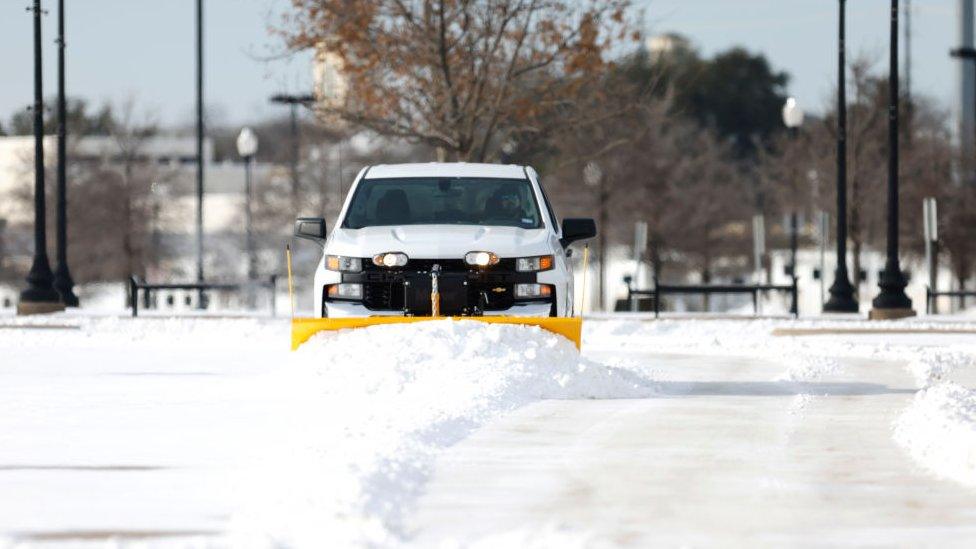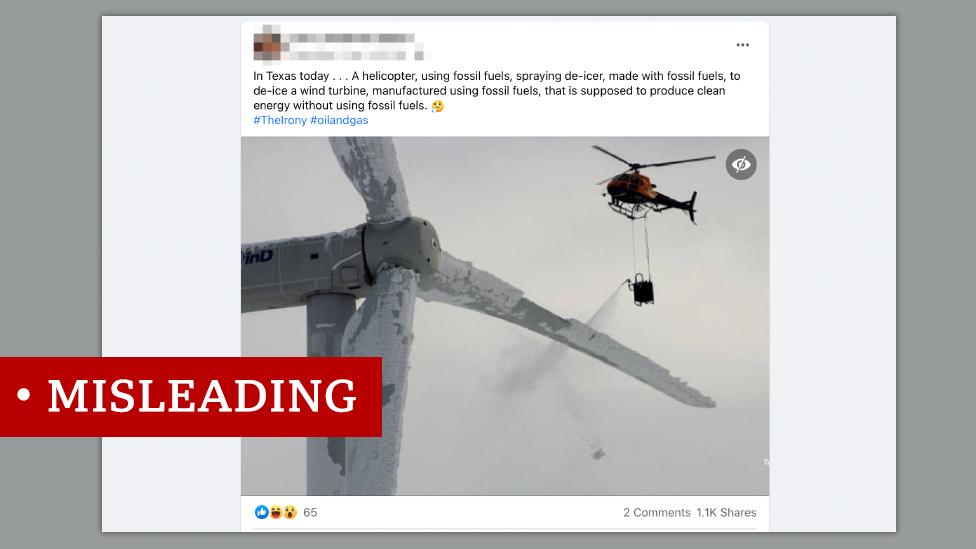Texas weather: Are frozen wind turbines to blame for power cuts?
- Published
Frozen turbines and climate change: The politics behind the Texas power failure
Critics of green energy in the United States have blamed the failure of wind turbines for the power shortages in Texas during the recent freezing conditions there.
"The windmills failed like the silly fashion accessories they are, and people in Texas died," said Fox News's Tucker Carlson.
The power grid was clearly overwhelmed, but to what extent was a loss of wind power to blame?
Was wind-power failure the problem?
Texas has promoted the development of wind energy over the past 15 years, and some of these turbines certainly froze in the recent bitingly cold conditions
But so did vital equipment at gas wells and in the nuclear industry.
And these failures in the non-renewable energy sector had a much greater impact.
So although nearly half of Texas's wind-energy capacity was lost at the peak of the freeze, twice as much overall was being lost from other sources.

A winter storm brought historic cold weather and power cuts to Texas
Breaking down the numbers
On average, renewable energy sources - mostly wind - account for about 20% of the state's electricity supply, external.
At the height of the freeze last week the state's principal energy supplier, the Electricity Reliability Council of Texas (ERCOT), said the freezing conditions had led to, external:
30GW being taken offline from gas, coal and nuclear sources
a 16GW loss in capacity in wind and other renewable energy supplies
And this, it said, had severely curtailed its ability to satisfy a peak demand of 69GW - a surge even greater than anticipated.
The company's Dan Woodfin said: "It appears that a lot of the generation that has gone offline today has been primarily due to issues on the natural gas system."
The cold weather also affected, external a water system needed to run the South Texas Nuclear Power Station, causing one reactor to shut down. Nuclear provides around 10% of the state's power.
Dr Joshua Rhodes, at the University of Texas at Austin, tweeted: "There is no single resource to blame for this.
"We usually think of peak events happening over a couple of hours. This one is lasting days.
"Wind has been below expected output. But so have other sources."

Why weren't the turbines self-defrosting?
Turbines can be equipped to deal with freezing temperatures.
"The wind energy industry has almost five decades of experience designing wind turbines to operate in freezing temperatures in harsh climates," says Prof Benjamin K. Sovacool at the University of Sussex.
Turbine blades can be heated, special anti-freeze fluids used, along with better insulation of gearboxes.
The blades themselves can also designed for performance in sub-zero temperatures.
But this only makes economic sense in places that regularly experience extreme conditions, such as in Alaska, Canada and northern Europe.
"Operators [in Texas] didn't invest in the usual weatherization or ice protection techniques says Prof Sovacool "because generally they didn't expect it to become so cold,"
Why didn't Texas get energy from elsewhere?
Texas is the only state in the US with an independent power grid.
In normal times, this works fine because Texas is a large producer of energy and can provide enough for its population and export to other states.
But when its infrastructure is under strain, for example during this latest freeze, it's largely unable to link up with other grids outside Texas to make up the shortfall.
Texas officials have now called for a hearing into the state's grid's ability to cope with extreme weather events.
Misleading claims on social media
The debate about renewable energy and the blackouts in Texas has also prompted the sharing of misleading claims online.
One image widely circulating on Twitter and Facebook shows a helicopter de-icing a wind turbine, with some comments suggesting it is in Texas.

"In Texas today... a helicopter, using fossil fuels, spraying de-icer, made with fossil fuels, to de-ice a wind turbine, manufactured using fossil fuels, that is supposed to produce clean energy without using fossil fuels," one Facebook post says.
But the picture actually shows ice being removed from a wind turbine in Sweden, using hot water.
BBC News traced the image back to a 2016 report published by Swedish company Alpine Helicopter, demonstrating "airborne de-icing solutions" for wind turbines.
Reporting by Christopher Giles, Jake Horton and Olga Robinson.

